PCD drills are considered high-end cutting tools, due to their rather complex manufacturing process and their higher market price compared to regular Tungsten Carbide drills.
In this ever-evolving composites materials market, the number of applications increase constantly, not only for the traditional aerospace segment, but also for Automotive, Wind turbines, Marine, Infrastructure and sports.
The use of PCD drills in composites is crucial for hole quality, process stability and cost effectiveness.
In this article we will explain why PCD drills are the best option an end user can choose for his composite application
You can divide the manufacturers of composite materials parts, which require hole making, into 3 types: End-users who use mainly PCD drills including regrinding services; End-users who use mainly CVD drills; End-users who use mainly carbide drills.
Tools price Vs. Process cost
While most buying decisions are price driven, there is no argument about end-users with low volume usage of drills and the best option for them probably is to search for the lower priced tool which complies to their requirements. In most of the times, it would be a Tungsten Carbide tool, which considered economical in price.
However, when large number of holes or large number of parts are about, the measurement of tool price only may be misleading. It is advisable in this case to look in a wider perspective.
The cost of cutting tools in an average manufacturing plant may vary between 5-10% of production cost, therefore saving the money on a chipper but less efficient tool is not worthwhile in most cases. The best measurement of tool effectiveness is by checking the entire machining process while measuring the cost of the tool divided by number of meters (in case of an endmill) or number of holes (in case of a drill).
When using CVD drills, the measurement is straight forward, by dividing the price of the tool to the average number of holes it is making. This would be the normal cost of the drill.
In case of using PCD drills, this measurement is not enough, since PCD drills can be resharpened few times and an overall life expectancy and overall number of usages must be measured.
But before we discuss this further, let’s try to remember the differences between Tungsten carbide, PCD tools and CVD diamond coated tools.
PCD Vs CVD Vs Tungsten Carbide

PCD (Poly Crystalline Diamond) is produced synthetically by sintering together many diamond particles, usually in the size of 2 to 30 microns of a meter, with a metal binder (usually Cobalt) at high temperature and high pressure. The hardness of the PCD is at the range of 6500-7000 Hv.
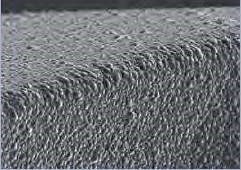
CVD Diamond (Chemical Vapor Deposition) – is a process of
coating Nano diamond particles on a Tungsten carbide substrate (tool) applying a typical layer thickness of 6 to 14 microns of a meter. The hardness of the CVD Diamond is at the range of 8500-9000 Hv.
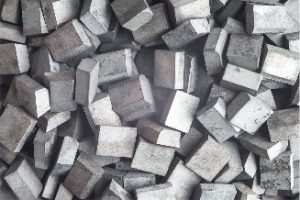
Tungsten Carbide (TC) is a hard material compound with W and C double the density and stiffness of steel, used as sintered with cobalt as the binder, mostly to produce cutting tools. Typical hardness is 1500-1800 Hv.
Comparing these 3 tool materials, it is evident that PCD and CVD are much harder than Tungsten Carbide therefore much more wear resistant. There is an advantage to the CVD diamond coating in terms of hardness on the PCD, though much smaller.
When delamination is the failure criteria, CVD diamond drills are likely to perform better than the PCD wafer (segmental) drills due to the superior hardness of the cutting edge in minimizing delamination at the hole exit.
This is one of the major concerns in the drilling of composites in highly engineered parts in the Aerospace.
The TC drill is likely to wear very fast due to much lower hardness, so it creates more deflection and delamination than the PCD and CVD drills. It is known that tool life differences between TC tools and Diamond tools can be up to 25 times in favor of the diamond.
When hole diameter is the failure criteria, then the PCD drill is likely to hold longer than CVD drills. The reason for this is since CVD diamond is a coating implemented on top of TC substrate. When it eventually peels off, it would expose the tungsten carbide underneath and edge wear will accelerate rapidly.
The PCD, on the other hand, is a solid diamond. Wear development rate is rather fast at the very beginning when edge radius develops but then it stagnates for long period of time.
Another example where PCD have an advantage is when drilling a stack material like CFRP/Aluminum, where the exit hole is in the Aluminum. Delamination is a non-issue in this case, therefore PCD drill would be first choice since it will hold hole accuracy longer and can also be reconditioned few times (unlike CVD drills).
Another major advantage of the CVD diamond drill would be design flexibility. The CVD drill is manufactured in 5-6 axis grinding machine to a complete geometrical design and later is being diamond coated, whereas most of PCD drills in the market are based on straight segments which limit the design flexibility.
Design flexibility is critical when building a point geometry to tackle composites.
Wafer PCD vs. Full-nib PCD
Now we must explain the two different types of PCD drills: the Wafer drill and the Full-nib drill.
In the wafer (segmental) drill, PCD segment is in the drill center and drill geometry is built around it, while being limited to its shape and size.

On a Full-nib PCD drill, on the other hand, the PCD has a cylindrical solid shape on top of the carbide shank, therefore drill point design has no limitations.
Most of hole sizes in composites are in the range of 2.5mm to 8mm in diameter. This is the range of diameters where PCD Full-Nib drills can be most efficiently manufactured and utilized, since larger diamond nibs are quite expensive.

The new Helicon Full-nib PCD drill
Telcon has developed the New Helicon Drill for extended tool life, accuracy and repeatability while maintaining delamination-free results.


Unlike PCD wafer drill, The Full-nib PCD allows for flexible design. The new Helicon is designed with 2 point-angles with slower, more gradual penetration into the material.
The consequence of that is lower thrust force on the material and much lower delamination and deflection of the composite materials.
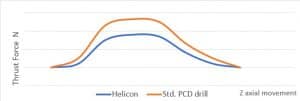
Case Study comparing PCD vs. CVD vs. Tungsten Carbide drills:
The application is drilling a CFRP unidirectional material, 5mm in thickness with diameter 4.87mm (.191″).
4 drills were tested:
- A tungsten carbide uncoated dagger style drill 4.87mm.
- A Helicon PCD Full-nib drill 4.87mm.
- A PCD wafer drill 4.87mm.
- A CVD diamond drill 4.87mm.
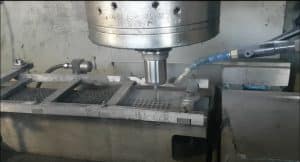
test setup
Drilling cutting conditions are based on common practice in drilling composites.
| RPM | Feed mm/min | |
| Tungsten carbide drill | 3800 | 180 |
| PCD Wafer drill | 6500 | 300 |
| PCD Helicon drill | 6500 | 300 |
| CVD diamond drill | 6500 | 300 |
Test criteria is the size of generated Delamination. Failure occurs when delamination is more than 1mm further from hole circumference.
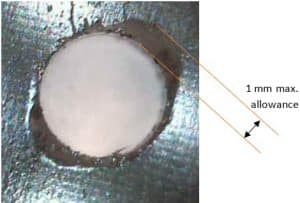
Drilling results were monitored every 200 holes for the diamond drills and every 100 holes for the TC drill. Then, holes were checked and marked for G/NG.
Final test results are gathered in the table and diagram below:
| Number of holes until delamination criteria | Hole size reduction from 1st to last hole (µ meter) | |
| Tungsten carbide drill | 85 | 25 |
| PCD Wafer drill | 760 | 10 |
| PCD Helicon drill | 1730 | 15 |
| CVD diamond drill | 1480 | 20 |
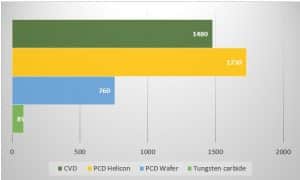
It is evident that the Tungsten carbide drill has much lower tool life as expected. The reduction in diameter from 1st to last hole is also the largest.
The Helicon drill has the best tool life while the CVD drill is second. The Wafer drill is approx. 50% in life compared to the Helicon drill. It is noticeable that the CVD drill has higher hole
diameter reduction than the PCD drills.
Cost comparison:
To better emphasize the significance of these results, let us make a cost comparison based on this test:
| Tool cost $ | Number of resharpening | Resharpening cost $ | Total cost $ | Total number of holes | Total cost/hole $ | |
| Tungsten Carbide Drill | 45 | 3 | 15 | 90 | 340 | 0.265 |
| PCD Wafer Drill | 181 | 3 | 63 | 370 | 3040 | 0.122 |
| PCD Helicon Drill | 198 | 3 | 69 | 405 | 5190 | 0.078 |
| CVD Diamond Drill | 132 | N/A | N/A | 132 | 1480 | 0.089 |
Summary and conclusion:
1. It is shown that PCD Full-nib drill, Helicon, is superior in tool life and normal cost (cost per hole).
2. It is shown that CVD drills are a very good solution when it comes to preventing delamination, although cost per hole is slightly in favor of the Helicon Full-nib drill. However, when hole accuracy is held within thin boundaries, the Full-nib drill outperforms the CVD drill.
3. It is also shown that the use of Tungsten carbide drills cost 3 times more than the use of PCD Full-nib drill, therefore advisable to be used only where there are fewer holes per part or lower number of parts to produce.
4. Setup time is excluded from this comparison, however if to be added, differences would be even higher, since tungsten carbide drills would need much more frequent replacements and will consume more machine idle time.
5. Feed rate comparison is excluded as well, and if considered, the Diamond drills are 67% faster in table feed, so machine time can be saved.
